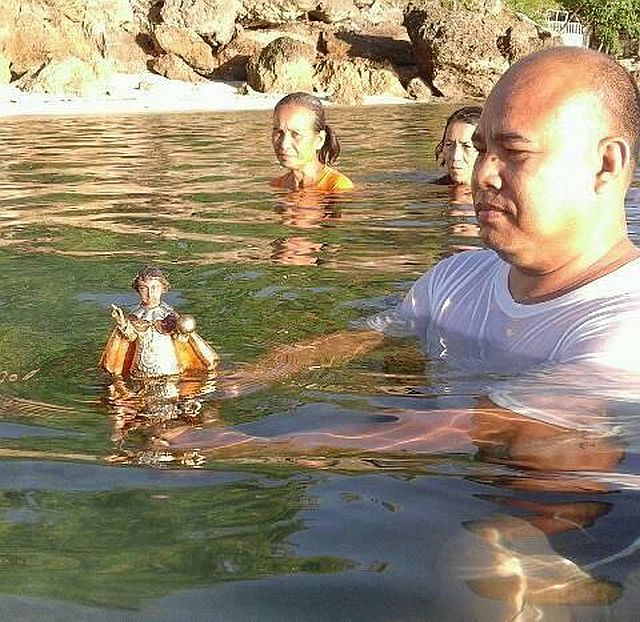
Fr. Romeo Desuyo, parish priest of Odlot, Bogo City, immerses the image of the Sto. Niño in the sea in supplication to God to end the drought. This is the “Ligo Senyor,” an ancient practice of dipping the image of the Sto. Niño in the sea to pray for rain. (Contributed photo)
A small fishing village in northern Cebu yesterday turned to an ancient practice of seeking divine intervention to end the dry spell that has been affecting the province.
At 5:30 a.m. yesterday, Fr. Romeo Desuyo, parish priest of the Birhen De Los Remedios Parish in Odlot, Bogo City, along with a number of parishioners, brought an image of the Sto. Niño de Cebu to the nearby shore.
As the sun rose over the horizon, the priest, wearing a white shirt and dark shorts, waded knee-deep into the sea, raised the icon of the Sto. Niño high up in the air and then immersed it in the waters and let it stay there for an hour.
Fr. Desuyo then led the faithful in prayer for rain and respite from the drought.
“Our plants have withered and the soils have dried up. We need to pray because we do not have the power to pour out rain on our parched land. Only God can do it. And so we put our trust in the Lord,” he told CDN.
ANCIENT PRACTICE
Fr. Desuyo explained that the practice of bathing the image of the Sto. Niño in the sea during droughts dates back to ancient times.
He said the natives had only to immerse the icon in the sea and the rains would come.
At that time, the ancient Cebuanos would use the original image of the child Jesus that was given by Portuguese explorer Ferdinand Magellan as baptismal gift to Cebu’s Queen Juana in 1521.
Fray Gaspar de San Agustin wrote about it in his book “Conquistas de las Islas Filipinas.”
The practice of immersing the sacred image is also mentioned in the Sto. Niño’s Gozos or prayer hymn published in a 1888 novena.
“Cun ulan ang pangayoon ug Imong pagadugayon, dad-on Ca sa baybayon ug sa dagat pasalomon, ug dayon nila macuha ang ulan nga guitinguha,” a stanza of the song reads.
(If they seek rain and You delay it, You will be brought to the shore, and bathed in the sea. And they then obtain the rain they desire.)
Fr. Desuyo said the “Ligo Señor” or the practice of immersing the Sto. Niño in the sea, coupled with prayers, seems effective as narrated in ancient books.
After the ritual, he said it rained in the island across Odlot, while the skies in the village became cloudy.
ORATIO IMPERATA
Last Wednesday, the Catholic Bishops’ Conference of the Philippines (CBCP) has issued an Oratio Imperata or mandatory prayer for rain.
The special prayer written in English and Cebuano is for consideration of the dioceses.
Cebu Archbishop Jose Palma adopted the CBCP prayer and yesterday urged all priests in the archdiocese to lead the people in praying for rain, said Fr. Mhar Vincent Balili, the prelate’s personal secretary.
The Oratio Imperata issued by CBCP seeks God’s mercy to send rain to those affected by the dry spell.
“Prolonged drought is depriving us of the fruits of our toil;
Low water supply means hunger and thirst for most of us;
El Niño continues to threaten our relationship with one another.
O Lord, this is a very hostile phenomenon that we beg for You to end.”
“O Loving God, behold on us, Your beloved children.
Feel us, feel for us; let heaven cry and its tears be our blessed rain.
Have mercy on us Lord, have mercy. We beg you, most gracious and merciful God. Please, let it rain.”
Desuyo, meanwhile, said they will continue to storm heavens with prayer until God will send them enough rain.
“We need to schedule when will be the next time we will bring and bathe the Sto. Niño in the sea,” Desuyo said.
“We need to pray. And when we pray, we believe. Prayer is powerful more than anything else,” he added.
Cebu City and the entire province have been placed under a state of calamity due to the El Niño phenomenon.
The drought affected at least P13.4 million worth of crops planted in 87.4 hectares of land in 28 mountain barangays of Cebu City.